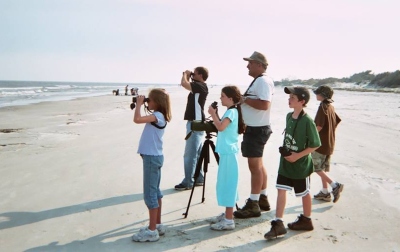
Race 4 Birds uses concept to expand birding among the young
Tim Keyes has been waiting for the Youth Birding Competition to take flight outside Georgia.
That wait ended with this week’s launch of Race 4 Birds Foundation, a nonprofit inspired by the event Keyes founded in 2006 and focused on promoting birding among youth nationwide.
Packing name and PR power – founders include international birding author Richard Crossley and Virginia-based businesswoman Constance Campanella – Race 4 Birds offers guidance and other resources groups can use to organize youth birding competitions at local and larger levels (video).
Keyes, a wildlife biologist with DNR’s Nongame Conservation Section, is hopeful. “It’s been such a pleasure to see it take off in Georgia. … It would be incredibly exciting to see it go in other places.”
Held each spring, Georgia’s Youth Birding Competition is a 24-hour, statewide search for birds featuring teams from pre-schoolers to high school seniors, and from first-time birdwatchers to budding ornithologists. About 100 youth took part this year. Some long-time participants have even helped mentor beginners, advancing the competition’s goal of spurring a wider interest in birds and conservation.
Partners such as TERN, Georgia Ornithological Society and Atlanta Audubon Society have provided critical and consistent support.
Race 4 Birds also closes the circle, in a sense.
While competing in the 2005 World Series of Birding in Cape May, N.J., Keyes noticed the number of young birders. The next morning, he talked with Crossley, who had recruited some of those teams, about ways to get youth interested in birding.
Keyes returned home and wrote a successful TERN grant request -- “without any real confidence it would work,” he adds, laughing.
It worked. And it continues to, now on a potentially much grander scale.
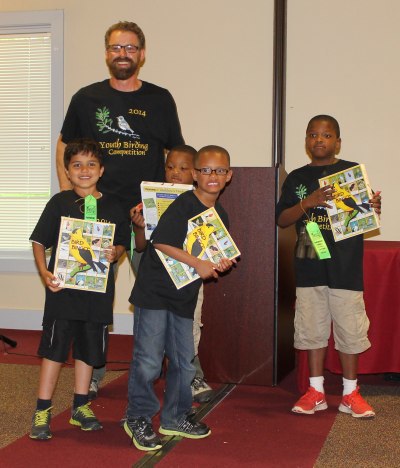
Georgia influence
The Peach State part of Race 4 Birds reaches beyond Keyes, a foundation director (above with the Crazy Cardinals birding team). Another Georgian, Dr. Lowell “Rusty” Pritchard, serves on the board. Giff Beaton, Bob Sargent and Georgann Schmalz, all of Georgia, are part of a Mentor Advisory Board. And Decatur teen Angus Pritchard, a Youth Birding Competition veteran, Rusty’s son and grand prize winner of this year’s T-shirt Art Contest, is on the Youth Advisory Board.
YBC upgrades
In nine years, the Youth Birding Competition has worked out contest kinks and expanded its scope. Organizers have switched from an 18-hour period to 24, added a conservation fundraising segment (participation is voluntary) and developed a successful T-shirt Art Contest focused on birds.
Back to top.
2014 TERN Outstanding Volunteer
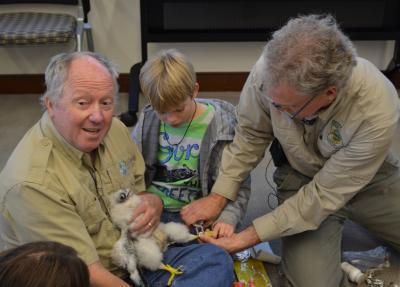
Marietta’s Greg Greer is a natural with wildlife.
He has been working with animals for 41 years, as a former Chattahoochee Nature Center director, Zoo Atlanta herpetologist, International Expeditions guide and now point man in a “reptile roadshow” that reaches 20,000 children a year and keeps him busy behind the scenes caring for some 100 animals.
In between, Greer rescues wildlife (“Rescued falcon sees Rock City,” July 30, 2012) and volunteers with DNR for everything from banding peregrine falcons (left, above) to surveying alligator snapping turtles.
What comes less naturally?
Responding to recognition, such as the recent news that The Environmental Resources Network had named him its Outstanding Volunteer for 2014. Greer said he feels honored and “non-deserving.”
“I do what I do because I love doing it. And to get an award? Holy smokes!”
In making the nomination to TERN, the friends group of DNR's Nongame Conservation Section, Nongame Program Manager Jim Ozier noted Greer’s work with peregrines, such as his fast response when a fledgling is found injured, and his help with reptiles, including contributing new county records of amphibians and reptiles to the state Herp Atlas project.
“Greg is an effective and appreciated ambassador for wildlife conservation in Georgia,” Ozier wrote.
Greer said he enjoys volunteering with the DNR. His good fortune, he writes, is being able to have a long career in wildlife work.
“For me, it comes entirely natural out of a love and lifelong passion … in never wanting to do anything but be a student of natural history.”
Picking favorites
Does Greg Greer have a favorite species? Well, yes. Although an obvious reptile fan, he favors peregrine falcons. In the 1970s, he worked for The College of William & Mary on reintroducing peregrines in Virginia. He said researchers referred to them as pedigree falcons, because they cost as much as $2,000 each. “It was like buying a pedigree dog.” He has seen peregrines around the world – in Asia, Africa, Patagonia. And each spring in Atlanta, he spends hours monitoring nests and fledglings. “I never tire of watching (peregrines).”
.
Noteworthy
Nongame Conservation Section’s new chief is a veteran nongame leader. Dr. Jon Ambrose joined DNR in 1986 as an ecologist and has worked since 2004 as assistant chief of the Nongame Conservation Section. He replaces Mike Harris, who left for a position at the U.S. Fish and Wildlife Service. Wildlife Resources Division Director Dan Forster said Ambrose’s “strong education and experience coupled with his commitment and familiarity with the section and division missions will serve him and our efforts well leading this critical unit forward.” (In the next Georgia Wild: Q&A with the new chief.)
Summer’s first loggerhead hatchlings dug out of a Tybee Island nest on July 12, an emergence documented by Georgia Sea Turtle Cooperative member Tammy Smith. Some eggs on other islands, including Ossabaw and Jekyll, have since hatched. While nest totals for the federally threatened species is down from previous record-setting years, DNR Sea Turtle Program Coordinator Mark Dodd is still hopeful of reaching the 25-year average of 1,200 nests. Nest updates.
Critical loggerhead habitat in the Atlantic and along the Atlantic and Gulf coasts has been designated in rules recently finalized by the National Oceanic and Atmospheric Administration and the U.S. Fish and Wildlife Service. Critical habitats include near-shore reproductive areas off nesting beaches from North Carolina through Mississippi, and 88 nesting beaches in the six states.
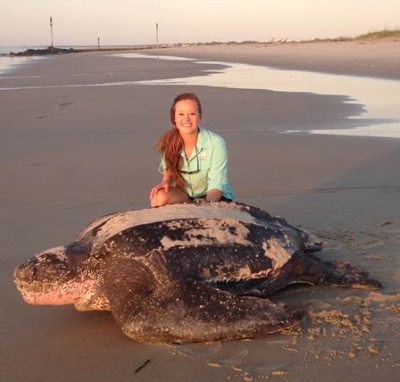
While loggerheads are Georgia’s primary nesting sea turtle, they aren’t the only species that nests here. This summer, the Sea Turtle Cooperative has recorded three green sea turtle nests and two by leatherbacks, the world's largest turtles (above: morning nesting leatherback at Sea Island).
Led by botanists Carrie Radcliffe and DNR’s Dr. Mincy Moffett, the Southern Appalachian Plant Society recently explored -- and helped census pitcherplants -- at The Nature Conservancy’s Reed Branch Wet Meadow and Eller Seep preserves. These blog posts cover the trips to Reed Branch in Towns County and just across the North Carolina line to Eller Seep.
Nongame staff are surveying hydric hammock and nonriverine wet hardwood forest habitats on the Georgia coast. The work to describe these rare habitats has included vegetation plots in four counties, with biologists discovering vegetation both mature and rich in species at many sites.
Invasive flathead catfish are under siege on the Satilla. From June 30-July 3, the Satilla River Native Fishes Restoration crew removed 1,003 flatheads totaling 1,176 pounds. That makes more than 37,970 fish topping 38 tons since the program began in 2007.
Blackbanded sunfish will be the focus of a $465,000 federal State Wildlife Grant to use environmental DNA techniques in verifying where this declining fish is found in Georgia and South Carolina. State-listed as endangered, blackbanded sunfish (below) are hard to detect using traditional survey methods such as netting and electrofishing (“Sought, found in south Georgia,” July 12, 2012). So-called eDNA analyzes water samples for genetic evidence that can indicate if a species is present. (“DNA hunt for hellbenders,” Nov. 29, 2013).
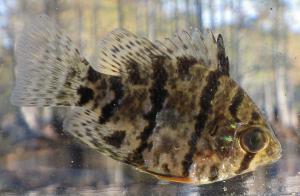
The Interagency Burn Team’s end-of-year meeting, led by Nongame fire management officer Shan Cammack, drew representatives from more than eight agencies and groups, including State Parks & Historic Sites, The Nature Conservancy, Forest Service, Longleaf Alliance and Georgia Forestry Commission. Topics varied from lessons learned (which are integrated into training) to a new Interagency Burn Team memo of understanding.
Growing-season prescribed burns were conducted recently on 450 acres of Mayhaw and Doerun Pitcherplant Bog wildlife management areas in southwest Georgia and 80 acres of Black Creek Natural Area in Taylor County. The Black Creek fires completed 420 acres burned there in recent months.
National Moth Week arrives with a flutter Saturday, offering citizen scientists worldwide a chance to help map moth distribution and other aspects of these insects. Learn more at nationalmothweek.org.
Four Florida men face federal and misdemeanor charges for illegally harvesting, selling and buying wild-caught freshwater turtles. Officials said three suspects caught and exchanged 2,100 pounds of turtles (one had 87 live softshell turtles), selling some to an Okeechobee turtle farm, whose owner also has been charged.
Names in the news: The Natural Resources Conservation Service has named Terrance Rudolph as state conservationist for Georgia and Katura Wright as assistant state conservationist for programs. Rudolph previously served as the North Carolina acting state conservationist, while Wright – who grew up in Georgia – transferred from Missouri where she worked as assistant state conservationist for programs.
Headlines
"Ga. wildlife officials seeking help counting bats," (Columbus) Ledger-Enquirer (and others via AP).
"Conservation property (Flat Tub WMA addition) holds promise for restoration and outdoor activities," Georgia River Network Water Trails News
"Marshall Forest has one of the last stands of old-growth pine-hardwood timber in northwest Georgia," The Nature Conservancy
"'Lost sharks' fade away while great whites grab the spotlight," NBC News
"Shining light on the 100-year mystery of birds sensing spring for offspring," ScienceDaily (citing research from Nagoya University)
"CatchMark to boost timberland holdings," Atlanta Business Chronicle
"What is next for Kitty Cams?" The National Geographic & University of Georgia Kitty Cams (Crittercam) Project
"Hungry, invasive ‘crazy worm’ makes first appearance in Wisconsin," University of Wisconsin-Madison
"If you really hate a species, try eating it," ScienceNews
Video
Battle between male gopher tortoises (by biologist Andy Day), Orianne Society
"Tortoises in Disney 3D (predator study involving model gopher tortoises)," Archbold Biological Station
"Middle Georgia bear surveys 2014," Ga. DNR
Parting shot
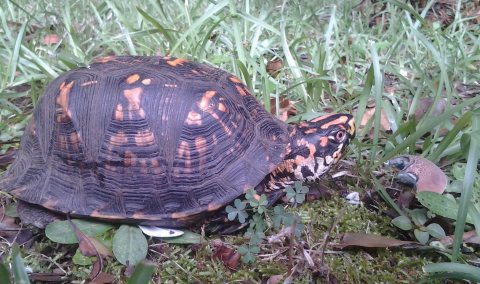
This eastern box turtle was making a meal out of a mushroom when Heather Jones
of Macon spotted it recently in her backyard, writes her father, Mike Jones.
Credits
** Georgia Wild masthead: luna moth. Alan Cressler
** Youth Birding Competition participants on the beach. Tim Keyes/Ga. DNR
** YBC coordinator Tim Keyes and members of the Crazy Cardinals, a primary school division team that raised the most funds for wildlife conservation in this year’s event. Linda May/Ga. DNR
** Greg Greer, left, holds a young peregrine falcon for banding by Nongame Program Manager Jim Ozier. David Allen/Ga. DNR
** Raleigh Nyenhuis with a morning nesting leatherback on Sea Island. Kelly Patton/Sea Island
** Blackbanded sunfish. Brett Albanese/Ga. DNR
** Box turtle. Heather Jones
|